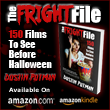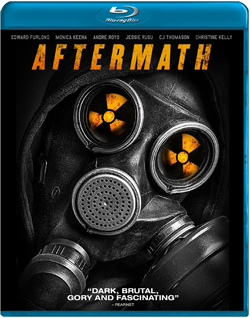A Production Production©1998–2025 Dustin Putman

|
 |
 |
|
Aftermath (2014)
Reviewed by Dustin Putman
 

(Release Date: August 26, 2014) – Since as early as 1954's "Godzilla," movies and television bred out of fears of nuclear war have become a subgenre all their own. 1959's "On the Beach," 1983's "The Day After" and "Testament," 1986's "When the Wind Blows," 1988's "Miracle Mile," and CBS series "Jericho" are just a miniscule smattering of projects that have dealt with this subject matter. Few of them, however, have been as graphically unsparing as "Aftermath," a crisp-black thriller where, horrifically, there can only be one conclusion. Director Peter Engert and screenwriter Christian McDonald earn points for not shirking away from their ghastly premise, but also save room for portraying humanity's propensity for kindness and empathy in the face of hopeless desperation. Unfortunately, a lack of character exploration, a few timeline head-scratchers, and at least one jarring stylistic motif used in a crucial final scene keep the film from reaching its highest aspirations.
NYC med student Hunter (C.J. Thomason) is passing across Northeast Texas as a nuclear attack on the U.S. comes to a head. After the electromagnetic force of the blasts stops automobiles in their tracks, his path crosses with a lone young woman, Elizabeth (Monica Keena), and a pair of siblings, teenager Jennifer (Jessie Rusu) and little brother Satchel (John Kennon Kepper). Seeking shelter in the farmhouse cellar of the friendly Jonathan (Ross Britz) and his great-uncle Wendell (Tody Bernard), the group of strangers—also including the pregnant Angie (Christine Kelly) and her short-tempered boyfriend Brad (Edward Furlong)—hunker down as they wait for the radiation to lessen. As the days pass by and their health deteriorates, frenzied outside forces close in.
As committed as the ensemble cast is, the characters are left underexplored, the varying facets of their personalities shining through much more than their pasts, families and the details that have led them to the present. Also problematic is an inconsistent timeframe: in one scene, a presidential address on the radio speaks of the events of the "last week" when it has been established as well over that, while the question as to what happened to one character who went upstairs days earlier to bury one of their own should be blatantly obvious. An awkward series of freeze frames near the end are also introduced so abruptly they temporarily pull the viewer out of the film. If the picture wasn't as involving and unsettling as it is, such stylistic flourishes wouldn't be as marked a hindrance. It's a seemingly small but not insignificant observation that director Peter Engert would do well to learn from in future projects.
Trapped in an unimaginable end-of-days situation, the people in "Aftermath" soldier forward, fighting for life as survival grows less and less likely. Locations are limited mostly to said basement and the surrounding farmhouse exterior, but this minimalism is a claustrophobic attribute to a plot where there is no escape. A stark, bittersweet comment on childhood's end and the forces we have no control over, the use of L. Frank Baum's "The Wonderful Wizard of Oz" as a running thematic parallel is an additionally affecting element. When the film ends, the statement it makes with its haunting last image—an emphatic symbol of both life and death literally held in the palm of the characters' hands—is as bleak as bleak gets. No one will be anointing "Aftermath" a feel-good triumph anytime soon, but there are flashes of unanticipated sensitivity and disquieting inspiration that cannot be denied.


A/B+

Crisp edges and impressive skin detail highlight the 1080p transfer of "Aftermath." This is an exceptionally vivid high-def treatment that lives up to its filmic intentions. Heavy filters are occasionally incorporated, giving some of the visuals an ashen-gray tint, but they fit well with the movie's tone and story. Grain is on hand as well, and it is lush and evenly resolved. Facial features emanate intricate detailing; for better or worse, every wrinkle and pore is present and accounted for. The 5.1 DTS-HD Master Audio is very good, but not outstanding. This is a dialogue-heavy film and keeps to the front of the sound field. When the action ramps up, so do the surrounds. Watching "Aftermath," there was nothing that really jumped out as being troublesome about the audio track, but also nothing to make me sit up and take notice.


It would have been nice to listen to a filmmaker's commentary track about the production, but Image Entertainment's Blu-ray of "Aftermath" is barebones on the special features front. Fortunately, the movie stands on its own, offering more food for thought than what many audiences might be expecting from a low-budget genre feature starring Edward Furlong (who, by the way, hasn't given a performance this good since the 1990s). A horrific drama rather than a straight horror movie, the terror of the film comes from a premise more plausible than one might like to imagine. For audiences who like their movies to not flinch in the pit of darkness, "Aftermath" is recommended.

|  |  |
|
© 2014 by Dustin Putman

|
|
|
